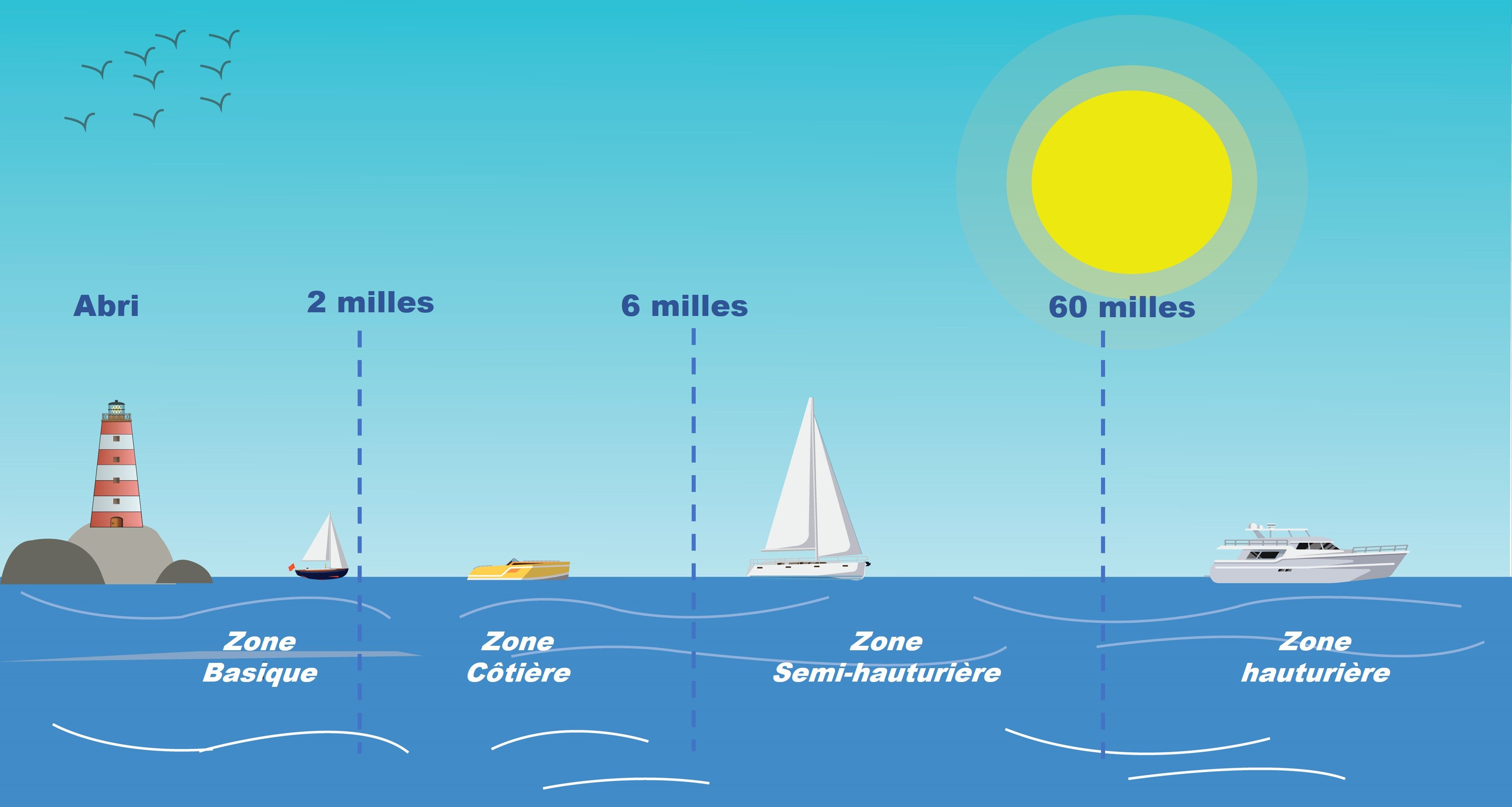Checking your equipment on board: an essential step

The end of winter is approaching, your boat will soon be refitted and/or put back in the water? You have just bought a used or even a new boat? These are good opportunities to review the safety equipment on board, both in terms of compliance and condition if it becomes necessary to use it while sailing.
The regulatory document that defines the conditions of use and the mandatory equipment for pleasure boating is called Division 240. This regulation concerns all boats used for pleasure and leisure boating.
The notion of safe port
This is an essential concept, because in Division 240, the equipment to be carried on board depends on the distance from a safe port or mooring. According to the official definition,"a shelter is a place on the coast where any craft or vessel and its crew can safely anchor, land or come alongside and leave without assistance. This concept takes into account the current weather and sea conditions and the characteristics of the craft, boat or vessel."
For a pleasure boat, 4 zones of distance from a shelter are defined:
- When sailing within 2 miles of a shelter, you are in the basic zone
- Between 2 and 6 miles from a shelter, you are in the coastal zone
- Between 6 and 60 miles from a shelter, you are in the mid-offshore zone
- Finally, beyond 60 miles from a shelter, you are in the offshore zone
The Picksea tip: how to determine if a place on the coast is a safe port?
The above definition leaves a lot of room for interpretation, so the notion of shelter must be analyzed in the following way:
- Does the place allow the boat to stop and immobilize: berthing, mooring to a trunk or a mooring body, anchoring on an anchor, beaching or "beachage"?
- Once immobilized, is the boat safe with respect to the weather and sea conditions and can the crew disembark safely and without risk?
- If the boat has to run aground or "beached": is it designed to be able to run aground (otherwise there is a risk of damage to the hull or the power plant)? Does the water level with the tide allow the boat to leave without assistance? Finally, does the state of the sea and its evolution allow a grounding without risks?
What should be on board in any case? (art 240-2.07)
You must have on board the equipment that allows you to comply with the RIPAM (reminder: International Regulations for Preventing Collisions at Sea):
- A black anchor ball and a black cone (for sailboats)
- Position lights for night navigation
- A foghorn or a horn
- The N&C flags of the international code of flags
- In addition, it will be necessary to verify that your boat is equipped with a means of reboarding (allowing to be put in place by a person located in the water) and in case of use of an outboard motor, that the circuit breaker is operational.
What should I have on board if I am not going more than 2 miles from a safe port ? (art 240-2.03)
- Each passenger must be equipped with a lifejacket, according to CE ISO or Solas standards, adapted to his morphology and with a buoyancy of at least 50 Newtons. For children, the buoyancy must be at least 100 Newtons.
- Each vest must be equipped with a watertight means of identification and a 6-hour autonomy: flashlight, cyalumine,... Otherwise, a waterproof flashlight, preferably floating, with a 6-hour autonomy is required on board.
- One or more fire extinguishing devices according to the indications of the "Owner's Manual" of the boat. In the absence of this document, the provisions of appendix 3 of the D240 apply.
- A means of manual drainage (bucket, bailer, hand pump, bilge pump) adapted to the volume of the boat if it is not self-draining or if it has a living space.
- The necessary equipment to allow the towing of the boat: mooring point fixed on board (cleat, mooring bitt) and a mooring line of at least 25 meters.
- A mooring line which must include: an anchor (weight adapted to the boat), chain (mesh size and weight adapted to the boat and length at least 1.5 times the length of the boat) and is extended by a rope which will allow the mooring to the boat (the length of the rope depends mainly on the average depth of the anchorage areas: the minimum to be foreseen is 3 times this average depth). It should be noted that boats with a light weight of less than 250 kg are exempted from a mooring line.
- A means of knowing the tide times and coefficients of the day and the navigation zone (except in the Mediterranean)
- Outside the territorial waters, the national flag must be flown.
What Picksea advises you to have on board in addition :
- A boat hook if the freeboard is more than 50 cm (the boat hook allows you to pick up an object in the water safely, without leaning overboard and taking the risk of falling into the water)
- A means of closing (pinochle) if the boat is equipped with a hull pass and valves
- Several mooring lines
- A first aid kit
What do you need to have on board if you are not going more than 6 miles from a safe port ? (art 240-2.04)
- All basic navigationequipment
- The life jackets can have a buoyancy capacity of 50 Newtons if they are effectively carried by all the crew members and if they are each equipped with a means of identification light. If they are not worn permanently by the crew members, the vests must have a buoyancy capacity of at least 100 Newtons. For inflatable life jackets, check the expiration dates and the state of the activation systems.
- A device for locating and assisting a person who has fallen into the water (horseshoe buoy and reversing light, IOR pole, rescue sling, ...). Exemption if all passengers wear their lifejacket equipped with a lighted locator at all times.
- Three hand-held red lights (with valid dates)
- A waterproof magnetic compass or a GPS system indicating the route followed.
- The nautical charts of the area frequented, kept up to date, in paper or electronic format. In the latter case, the electronic device for consulting and using the maps must be operational.
- The RIPAM or an extract of it in the form of a plate or a sticker
- A description of the waypoint or an extract of it in the form of a plate or a sticker
What Picksea recommends to have on board in addition:
- An electronic (depth sounder) and or handheld depth gauge.
- A 5W portable waterproof VHF
What to have on board if you are not going more than 60 miles from a safe port ? (art 240-2.05)
- All equipment for coastal navigation
- Life jackets must have a buoyancy capacity of 150 Newtons. For inflatable life jackets, check the expiration dates and the state of the release systems.
- One harness and lanyard per person on board a sailboat. For a motorboat, only one harness and its lanyard for the boat is required.
- A waterproof magnetic compass is mandatory
- A An operational 25 watt fixed VHF
- The equipment allowing to take stock, to trace and follow a route navigation ruler, bearing compass and dry point compass (if paper charts on board) or an operational electronic system.
- One a life raft with the CE ISO 9650 standards (
- A searchlight (to search for a person who has fallen overboard at night)
- A properly filled out logbook
- A light book for the navigation area
- A means of receiving weather information (beyond VHF range): SSB receiver or Navtex.
- One first aid kit compliant for offshore navigation (art 240-2.19)
What Picksea recommends to have on board in addition:
- To complement an electronic means of navigation with "traditional" means
- A 5 watt portable waterproof VHF
- A Grab Bag for crossings
What should I have on board if I am going more than 60 miles from a safe port ? (art 240-2.06)
- All the equipment for a semi-high speed navigation
- One ePIRB or EPIRB 406 Mhz waterproof distress beacon
- A portable waterproof VHF 5 watt operational
- A life raft to CE ISO 9650 standards (> 24 hours) or class II capable of carrying all passengers on board. Valid revisions.
What Picksea recommends to have on board in addition :
- A satellite communication device to be able to communicate with an MRCC and contact the Marine Medical Consultation Center.
- A sextant and tables for positioning in the event of a power failure on board or a stand-alone portable GPS for backup.






 By Marie de Picksea
By Marie de Picksea

